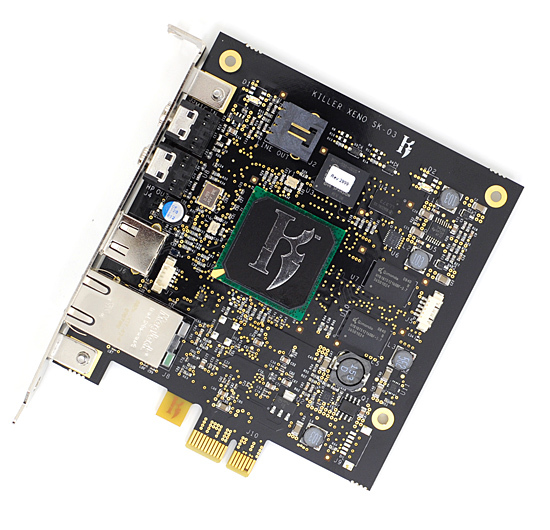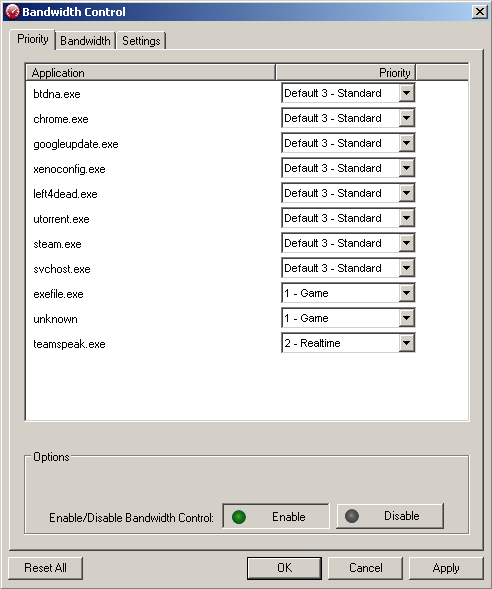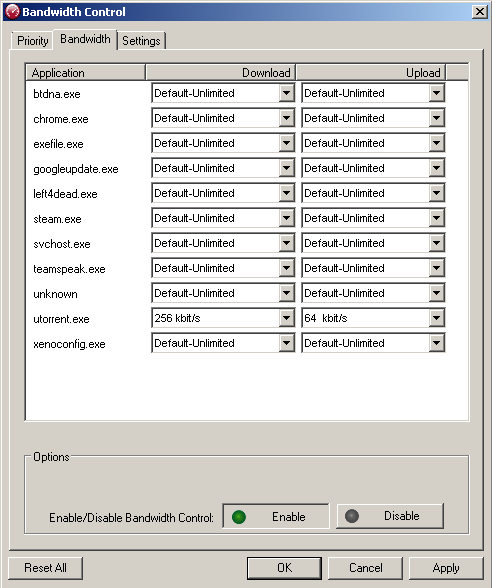EVGA Killer Xeno Pro: The Impact of Network Offloading
by Derek Wilson on July 3, 2009 4:20 AM EST- Posted in
- Networking
The Card and Features
This card sports a 400MHz PowerPC processor with 128MB of RAM, essentially making the Killer Xeno Pro a computer on a x1 PCIe board. As with the first generation, the major feature of the Killer Xeno Pro is it's ability to offload TCP/IP work from the CPU by bypassing the Windows TCP/IP stack.
Microsoft's built-in TCP/IP stack requires the CPU to handle network packet processing. Additionally, when packets arrive, they don't generate interrupts and applications must poll for data (which also wastes time and resources). Bigfoot Networks claims that the windows networking stack is not designed for low latency operation while the Killer Xeno Pro is. Regardless of how (or how efficiently) a software network stack is implemented, having it run in hardware will reduce overhead and impact on the rest of the system. It should also be noted that, for applications which require the windows networking stack (like some VPN products), the Killer Xeno Pro can disable it's "game mode" and enable "application mode" which does disable TCP/IP offload and can increase compatibility in some cases.
Adding to this, the Killer Xeno Pro hardware is capable of offloading other network centric tasks like VoIP, firewalls, and networked storage (though these features are not all fully supported with appropriate software at this point in time).

Installing the hardware is very straight forward, as it's just a simple PCIe card. If you want to use the voice chat features, the only additional need is to connect either the internal or external audio cable. No power is required, and other than that the network port is all that you'll need to worry about. Despite the fact that there is a USB port on the card, it is not used for anything at this point (but Bigfoot has indicated future potential to enable hardware managed USB attached storage).

Mic in and audio line out on a NIC; now that's a first.
The only installation issue we noted is that the driver install, when necessary, will also flash the Killer Xeno Pro hardware. There isn't very much warning about what's going to happen and no confirmation dialog before the start of the flash process. Those who click through install programs quickly without reading them might get themselves into a bit of trouble. There is no way to cancel the flash update once it's started, and while flashing hardware isn't as risky these days, it might be nice if the drivers were a little more clear about what was going to happen.

Easy mode switching.
The hardware comes with drivers and a tray application that are capable of bandwidth throttling and prioritization. Control can be down to a per application basis and maximum download and upload speeds can be specified. Or for benefit without the headache, applications can be prioritized allowing hardware and usage patterns to determine effective bandwidth. Unfortunately, the drivers and applications for the Killer Xeno Pro only run on Microsoft Windows operating systems (XP and Vista flavors). With the gaming focus, this makes sense, but it would still be nice for those who like to dualboot Mac OS X or Linux.

Per application QoS.

Per application bandwidth limits.
With software support, games and voice chat software can completely delegate any VoIP functionality to the Killer Xeno Pro which would handle taking input from the microphone (which plugs straight into the Killer Xeno Pro), compressing the data and sending it out over the network. When a voice packet is received by the Killer Xeno Pro, it decompresses it and sends it straight to the sound card (either via the soundcard's line-in port or an internal cable) bypassing the rest of the system completely. This should help reduce CPU overhead and voice lag caused by sources other than the network or server.
While this is great from a geeky technical standpoint, there isn't a huge amount of overhead on modern CPUs for voice chat software, and the network is by far the largest source of delay. So the actual benefit isn't going to be huge. These issues are the same with hardware firewall, bandwidth control, and all the extras.
The TCP/IP offload capability of the hardware will definitely remove another task from the CPU and operating system. This will free up resources that could be useful for other things, but the real world benefit of this will be very small in most games where the majority of the work is done on the GPU rather than the CPU. Having an NPU (network processing unit, as Bigfoot Networks likes to call it) that handles TCP/IP processing as soon as packets are received and uses hardware interrupts to let a game know that network packets have arrived (rather than requiring polling) can help decrease the latency between when a packet is received by the network card and when a game is able to make use of it, but as with the voice issue the largest delay is inherent in the internet itself and there is only so much benefit that can be had by optimizing the client side.
Not to say that optimizing client side networking is a bad thing: it certainly is not. The real question here is not whether the Killer Xeno Pro does something useful (because it does), the question is whether that useful thing has any significant impact on experience (and if that impact is high enough to justify the price).










121 Comments
View All Comments
mindless1 - Saturday, July 4, 2009 - link
The thing is, even with a slower CPU and PCI bottleneck, the network processing still isn't a substantial % of processing by the CPU, and the traffic for gaming not bottlenecked by PCI bus.Even a lowly Celeron 500MHz isn't much of an issue if jumbo frames are used, though CPU still has to be seen as a bottleneck to the gaming itself.
has407 - Sunday, July 5, 2009 - link
Jumbo frames won't do squat in this case, and will likely cause worse problems. Even in well--managed and closed environment, expect very little gain unless you're using a very fast SAN, fast switches, and a network admin who knows what they're doing.Do the math: even for 1Gbe networks the efficiency gain for most apps using jumbo frames is noise. For 10Gbe you might notice it if you've got enough CPU and IO bandwidth; for the typical home network, it's not worth considering.
davecason - Saturday, July 4, 2009 - link
PCIe, not PCI.Theunis - Saturday, July 4, 2009 - link
I wonder if it would be possible to use this board with my Linux x86_64 machine. LOLWouldn't it be cool to run specific applications compiled for PPC, to run on this board? Does it come with it's own RAM?
ShawnD1 - Saturday, July 4, 2009 - link
If they're trying to market this thing as something to reduce CPU usage, it doesn't really make much sense to test it with the fastest processor you can find. Try it with a CPU that has no speed at all, maybe a celeron or sempron.Of course that's not a real world test, but are any tests on Anandtech realistic? I don't run my games at 3000x2000 resolution, but ridiculous tests like that show us what a video card can do. For CPU tests we're looking at Phenom II and Core 2 Quad systems running games at 800x600 and getting 200fps. It's a ridiculous test, but it isolates the hardware being tested.
The methodology in the article, in my opinion, is like testing a bunch of video cards at 800x600. Seeing that every video card is getting 200fps (the CPU bottleneck), the conclusion would be that upgrading the video card is a waste of money. Similarly, testing something that reduces CPU bottlenecking should not be done with a CPU that isn't bottlenecked by any game in existence.
Gannon - Saturday, July 4, 2009 - link
This product has no real market, it's just an excuse to charge more money to clueless among the gaming population.What they should really do with this card is make it multi port and a router, I would love to ditch my piece of shit router that requires constant reboots because of someones Wifi dropping (it works fine for wires connections). If they could build a wireless router network add in card + network stack offloading + opening up the card to developers, then I'm in. Screw the "gaming" portion of it, how bout building a quality product gamers would want?
Such as: Bandwidth control (so users can't flog the connection can have their bandwidth limited so it doesn't fsk_up your ping in an online twitch game like quake 3, etc, etc... othe routers have attempted this like Dlinks "Gamefuel", so one can have torrents + game at the same time, no one has really done it very though.
The networking stack is the least of a gamers worries on a modern computer, there is a reason everything has become more integrated over time (audio + network), with the rise of the internet NOT having an ethernet port on a computer is stupid and most onboard NIC's are so good now-a-days unless you are doing some serious file transferring you don't need it.
Anyone claiming to see a performance benefit is shitting you, the real problem lies in input output latencies to devices, RAM and hard drives.
I'll take audio + NIC integrated on future CPU's with an integrated memory controller over add-in shite that is just going to fade away over the next 5-10 years.
Gannon - Saturday, July 4, 2009 - link
Also the next real major speed up for games is in Solid state disks, what we really need is:-Newer faster Memory technology, CPU spends most of it's time waiting on RAM (and ram is damn fast comparable to hard drives and even solid state drives).
-Newer faster permanent storage (SSDa and beyond)
When solid state disks mature and they finally come out with a chipset that can really take full advantage of SSD's and the bandwidth they offer we'll see a lot more performance improvement.
Try playing a game that chugs on an old hard drive, then put it on an SSD, notice it's not as choppy when things get harry. I noticed this when I moved many of my games from an older 320GB drive to my 1TB drive, games that were slow/choppy suddenly got a speed boost because the drive IO was a sever bottleneck, I can't wait to get an SSD once their capacity expands and price comes down to saner levels.
navilor - Saturday, July 4, 2009 - link
I have on my old machine (a Core2Duo E6600) the Bigfoot KillerNIC M1. I thought that it was a complete crock of [expletive deleted] until a buddy of mine bought one and reported a much better gaming experience.And what exactly did it do?
He played Everquest and it lowered his latency a lot. This means that his character is a lot more responsive to what is happening around him. Yes, you can disable Nagel's algorithm and do something similar, but that wasn't the end of it.
He was able to report being able to run with higher graphical settings enabled. It also removed a stutter that he previously did not notice.
So I sucked it up and decided to blow some cash on that product.
Excellent investment. No longer did my CPU have to manage TCP/IP packets. UDP packets were invisible (via WireShark) yet passed through to the OS without issue (there is a Game setting and an Application setting for those who need it).
This network card offloaded work so my CPU could be used to manage things. Now you might think that my CPU was lame. World of Warcraft, which is the game I play, barely touched the CPU at all. No matter how powerful your CPU is it still has to deal with networking.
Unless it doesn't because you have a KillerNIC.
Now did it lower my latency? No, but it did for my friend. Did disabling Nagel's algorithm help? Yes, but it didn't smooth out my frame rate. Combine the two and you will notice a difference.
On my new rig (Core i7 920 with a GTX 295 and 12GB of RAM) disabling Nagle did jack for me. I am considering either purchasing the new Xeno Pro or possibly stripping the M1 out of my old system. My card can run a firewall on it (iptables) so I don't have to burden Windows with that overhead.
Oh, and high end servers run network cards that do TCP offloading. I'm vaguely certain that those types of cards are there for a reason.
You can prioritize your packets all you want on the network, too. That is always a good first step. What the network cannot do is reduce the time it takes for your application to:
1). Generate a packet
2). Have it go through the windows networking stack
3). Go through the Windows network driver
4). And then out the cable.
The Killer products remove step two and the overhead of step three.
Windows, by default, likes to lump packets together for high speed transmission. See also Nagle's Algorithm. That can be disabled via a few registry hacks. Removing the overhead of Windows compressing those and shoving them through the driver smooths things out. If you have a KillerNIC then you can still manually disable Nagel (which lightens the workload of packet management a small amount) and let the KillerNIC worry about the rest.
So what this means is that the Killer products prioritize the packets INSIDE of your machine BEFORE they hit the home network to then be prioritized on your internet facing router.
DerekWilson - Sunday, July 5, 2009 - link
I get the things that the Killer is doing and that those things are real ...But if your friend took the $120 for the Killer Xeno Pro (or the likely much higher cost of the M1 at the time) and spent it on a faster CPU, the benefits would have extended to much more than just making packet processing faster.
It would have benefited many other applications as well in addition to delivering the performance needed for smooth network play.
has407 - Saturday, July 4, 2009 - link
I won't argue with your experience, as I haven't used one of these NICs. However, is it a cost-effective or appropriate way to solve the problem? Color me skeptical; the evidence is at best inconclusive.1. Nagle applies to TCP, not UDP.
= You aren't going to see any improvement disabling Nagle for apps that use UDP.
2. TPC_NODELAY is a way for apps to bypass Nagle.
= Apps with time-sensitive needs and that use TCP should use it. Nothing you can do about this, but I would hope and expect game developers would be cognizant of it and use it appropriately (or use UDP).
3. An old 2.2GHz Core-2 can drive > 150KBs of 1-byte packets with TCP_NODELAY; > 500KBs using 1-byte UDP packets; > 225MBs with 16KB packets; and peaks at ~300K segments/sec.
= For modern CPU's, CPU time is noise given typical Internet bandwidth.
= Latency/CPU due to the network stack is noise.
4. Some NICs have features which you may want to disable. E.g.:
- Interrupt coalescing. This reduces CPU load by not generating an interrupt for every packet. That may be counterproductive for games.
- Large send offload. Removes the CPU overhead of segmenting large packets into smaller ones and moves it to the NIC. Doubtful there'd be much difference unless the game is sending large packets (which I expect isn't the case).
- Jumbo frames. Don't. In this scenario they're at best a NOP and at worst will degrade performance.
In short, will the Killer NIC perform any better than a properly tuned system? I doubt it. Is the $premium worth the equivalent amount spent on a faster CPU or GPU, or the time required to tune the system? Your call, but again I doubt it.
p.s. No, disabling Nagle does not reduce "the workload of packet management a small amount". It exists to reduce per-packet overhead by coalescing small messages into larger packets.